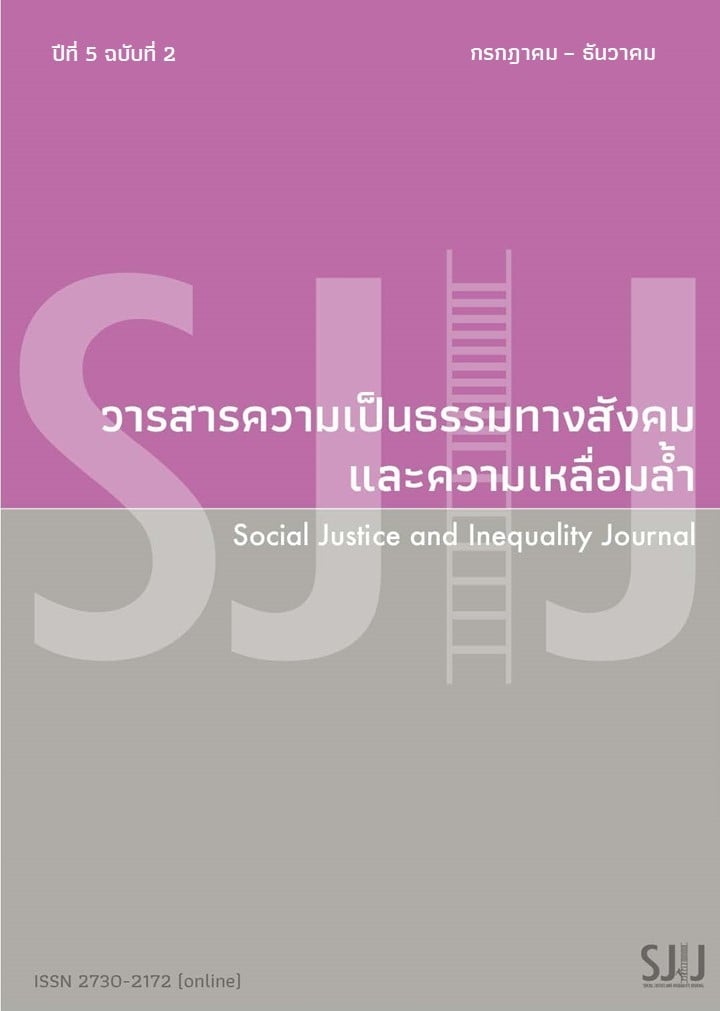Social determinants of drug use and the development of the quality of life of drug users
ปัจจัยสังคมกำหนดการใช้ยาเสพติดกับการพัฒนาคุณภาพชีวิตของผู้ใช้ยาเสพติด
Keywords:
Social determent of drug used, Quality of life, Drug userAbstract
The drug problem has adverse effects on individuals and society and is a severe problem in every society. When individuals use drugs and become addicted, it affects not only their own quality of life but also that of the people around them. This article aims to identify the social determinants of drug use in order to develop guidelines for improving the quality of life of drug addicts. This study used qualitative research and collected data from 25 drug users who had undergone treatment through snowball sampling. The study revealed that social factors determining drug use can be categorized into two main parts: personal factors and environmental factors, which include the lifestyle and behavior of people around the drug user, their social networks and communities, as well as societal structures. Therefore, addressing these factors at each level can contribute to improving the quality of life among drug users. Ultimately, a good quality of life for drug users entails having a stable life both economically and socially, maintaining positive relationships with others, having freedom in decision-making, and experiencing physical well-being, as well as enjoying good family life.
References
Assari S, Jafari M. (2010). Quality of life and drug abuse. In: Preedy VR, Watson RR (eds). Handbook of disease bur-dens and quality of life measures. Springer, New York, NY. 3691–3370. https://doi.org/10.1007/978-0- 387-78665-0_214.
Ball, J. C., & Ross, A. (1991). The effectiveness of methadone maintenance treatment: Patients, programs, services, and outcome. Springer-Verlag Publishing/Springer Nature. https://doi.org/10.1007/978-1-4613-9089-3
Beman DS.(1995). Risk Factors Leading to Adolescent Substance Abuse. Adolescence.30:201-8.
Creswell, J.W. and Poth, C.N. (2018) Qualitative Inquiry and Research Design Choosing among Five Approaches. 4th Edition, SAGE Publications, Inc., Thousand Oaks.
Ma, Z., Liu, Y., Wan, C. et al. (2022). Health-related quality of life and influencing factors in drug addicts based on the scale QLICD-DA: a cross-sectional study. Health Qual Life. 20, 109. https://doi.org/10.1186/s12955-022-02012-x
Mburu, G., Ayon, S., Tsai, A. C., Ndimbii, J., Wang, B., Strathdee, S. e Seeley, J. (2018). “Who has ever loved a drug addict? It’s a lie. They think a ‘teja’ is as bad person”: multiple stigmas faced by women who inject drugs in coastal kenya: multiple stigmas faced by women who inject drugs in coastal Kenya. Harm Reduction Journal, 15(1).
Morse, J. M. (2000). Determining sample size. Qualitative HealthResearch, 10, 3–5.
Pasareanu AR, Opsal A, Vederhus JK, Kristensen Ø, Clausen T. (2015). Quality of life improved following in-patient substance use disorder treatment. Health Qual Life Outcomes.13:35. doi: 10.1186/s12955-015-0231-7.
Pisitpunporn, J. (2011). Enforcing pattern, Process and Policy of Expunction of Criminal
Records for Criminal Justice Process in Thailand. Master of Laws Thesis, Chulalongkorn University, Bangkok.
Tai B, Volkow ND. (2013). Treatment for substance use disorder: opportunities and challenges under the affordable care act. Soc Work Public Health. 28(3-4):165-74. doi: 10.1080/19371918.2013.758975.
Wilkins C, Sweetsur P. (2010). The association between spending on methamphetamine / amphetamine and cannabis for personal useand earnings from acquisitive crime among police detainees in New Zealand. Addiction. 106:789-97
ฤดี กรุดทอง (2540). ประชากรกับการพัฒนาคุณภาพชีวิต. คณะมนุษยศาสตร์และสังคมศาสตร์ สถาบันราชภัฎสวนดุสิต.
บพิธ สนั่นเอื้อ. (2560). ปัจจัยที่มีผลต่อการอยู่ครบกระบวนการบำบัดฟื้นฟูสมรรถภาพผู้ติดสารเสพติดกรณีศึกษา: ผู้รับการฟื้นฟูสมรรถภาพแบบบังคับบำบัดด้วยโปรแกรมจิตสังคมบำบัดประยุกต์โรงพยาบาลบุ่งคล้า จังหวัดบึงกาฬ [ออนไลน์]. [สืบค้นเมื่อวันที่ 10 กุมภาพันธ์ 2567]; แหล่งข้อมูล: URL:https://bkpho.moph.go.th/ssjweb/bkresearch/require/files/post-doc/20171016143538.pdf
นัฐพงษ์ นาอุดม และ ศุอวัฒนากร วงศ์ธนวส. (2563). สาเหตุของการติดยาเสพติดกรณีศึกษา: ชุมชนคุ้มสระบัว ตำบลในเมือง อำเภอเมือง จังหวัดร้อยเอ็ด. Journal of Modern Learning Development. 3(6): 102-115.
ผกามาศ โรยทอง. (2565).ปัจจัยที่ส่งผลต่อการตัดสินใจเสพยาเสพติดของเด็กและเยาวชนที่เข้ารับการบำบัดในสถานบริการจังหวัดภูเก็ต. วารสารศาสตร์สุขภาพและการศึกษา. 2(3).
พิศมัย ทองเที่ยง. (2563). หลักการให้โอกาสผู้เสพผู้ติดยาเสพติดคืนคนดีสู่สังคมในสถานประกอบการด้วยพรหมวิหาร -สังคหวัตถุ4. วารสารMahidol R2R e-Journal, 7(2):16-29.
วนิดา รัตนสุมาวงศ์, รัศมน กัลยาณศิริ และพิชัย แสงชาญชัย. (2561). ทฤษฎีของพฤติกรรมเสพติดและข้อ ถกเถียงที่มีในปัจจุบัน. วารสารสมาคมจิตแพทย์แห่งประเทศไทย, 63(3), 295-306.
สำนักงานคณะกรมการการป้องกันและปราบปรามยาเสพติด. (2565). รายงานผลการดำเนินงานป้องกันและปราบปรามยาเสพติด ประจำปีงบประมาณ พ.ศ. 2564. กรุงเทพ.
อัจฉราพร สี่หิรัญวงศ์ และ ประภา ยุทธไตร. (2556). ปัจจัยสัมพันธ์กับพฤติกรรมการใช้สารเสพติดในทางที่ผิดและติดสารของผู้เข้ารับการตรวจพิสูจน์ในระบบบังคับบำบัด. วารสารสมาคมจิตแพทย์แห่งประเทศไทย. 58(4): 371-384

Downloads
Published
Issue
Section
License
Copyright (c) 2024 Social Justice and Inequality Journal

This work is licensed under a Creative Commons Attribution-NonCommercial-ShareAlike 4.0 International License.



